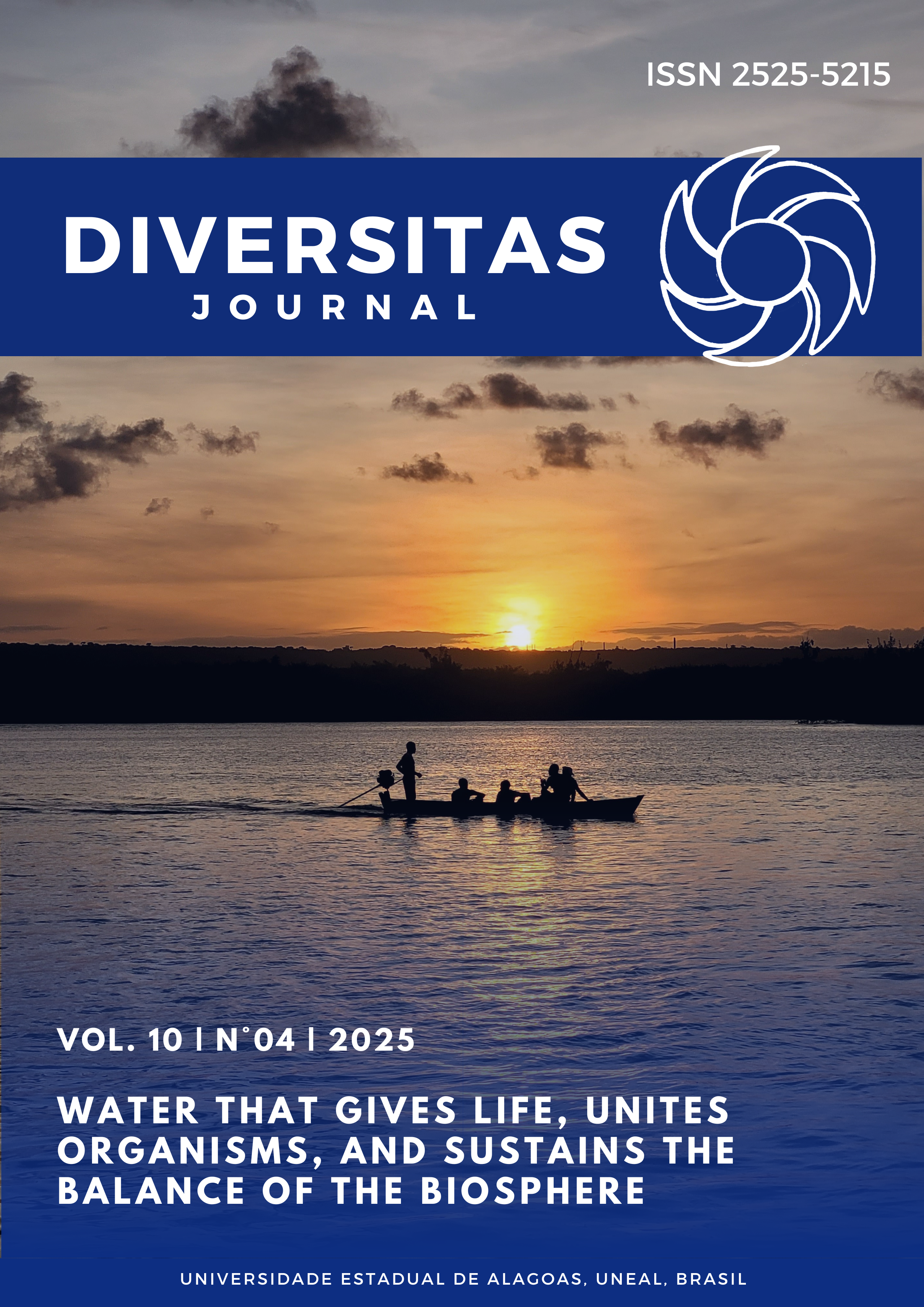Obesidade na Infância e Adolescência: uma Revisão
DOI:
https://doi.org/10.48017/dj.v10i4.2665Palavras-chave:
obesidade infantil, obesidade adolescente, sobrepeso, fatores de risco, teoria cognitivo-comportamentalResumo
A obesidade na infância e adolescência é considerada um importante problema de saúde pública nacional e globalmente, pois resulta em vários problemas de saúde e complicações psicossociais de longo prazo. Além disso, essa preocupação vem crescendo devido ao sobrepeso e à obesidade, apresentando um aumento mundial de mais de 340 milhões de crianças e adolescentes de 5 a 19 anos com excesso de peso. A investigação tem produzido uma vasta literatura sobre obesidade, nomeadamente ao nível do impacto da intervenção com terapia cognitivo-comportamental. No entanto, as conclusões deste artigo de revisão apontam para a necessidade de intensificar a investigação da obesidade na infância e adolescência, para que este problema possa ser acompanhado desde tenra idade, minimizando o impacto das consequências a médio e longo prazo.
Métricas
Referências
Adams, E. L., Caccavale, L. J., Smith, D., & Bean, M. K. (2020). Food insecurity, the home food environment, and parente feeding practices in the era of COVID-19. Obesity (Silver Spring), 28(11), 2056-2063. doi: https://doi.org/10.1002/oby.22996
Allabadi, H., Dabis, J., Aghabekian, V., Khader, A., & Khammash, U. (2020). Impact of COVID-19 lockdown on dietary and lifestyle behaviours among adolescents in Palestine. Dynamics of Human Health, 7(2). doi: http://www.journalofhealth.co.nz/?page_id=2170
American Heart Association, Gidding, S. S., Dennison, B. A., Birch, L. L., Daniels, S. R., Gillman, M. W., Lichtenstein, A. H., Rattay, K. T., Steinberger, J., Stettler, N., Horn, L. V. (2006). Dietary recommendations for children and adolescentes: a guide for practitioners. Pediatrics, 117(2), 544-559. doi: https://doi.org/10.1542/peds.2005-2374
Bombak, A. E., Meadowns, A., & Billette, J. (2019). Fat acceptance 101: Midwestern american women’s perspective on cultural body acceptance. Health Sociology Review, 28(2), 194-208. doi: https://doi.org/10.1080/14461242.2019.1604150
Castelnuovo, G., Pietrabissa, G., Manzoni, G. M., Cattivelli, R., Rossi, A., Novelli, M., Varallo, G., & Molinari, E. (2017). Cognitive behavioral therapy to aid weight loss in obese patients: current perspectives. Psychology Research and Behavior Management,10, 165-173. doi: https://doi.org/10.2147/prbm.s113278
Chan, C. M. S. (2014). Health-related quality of life of preschool caregivers in Hong Kong. Health Promotion Internacional, 29(2), 287-295. doi: https://doi.org/10.1093/heapro/das058
Curry, S. A. (2017). Obesity epidemic: Pharmaceutical weight loss. Rhode Island Medical Journal, 100(2), 18-20.
de Paula, M. B., Santos, I. L. L., Ide, B. H., Moraes, B. L., de Mello, E. V., & Rabelo, I. O. (2022). Intervenções direcionadas ao sobrepeso e obesidade infantil: uma revisão narrativa. Brazilian Journal of Health Review, 5(2), 6354-6363. doi: https://doi.org/10.34119/bjhrv5n2-210
Davis, J. M. (2010). What is early childhood education for sustainability? J. M. Davis (Ed.) Young Children and the Environment: Early Learning for Sustainability (pp. 21-42). Melbourne: Cambridge University Press.
Forman, E. M., Butryn, M. L., Manasse, S. M., Crosby, R. D., Goldstein, S. P., Wyckoff, E. P., & Thomas, J. G. (2016). Acceptance-based versus standard behavioral treatment for obesity: Results from the mind your health randomized controlled trial. Obesity (Silver Spring), 24(10), 2050-2056. doi: https://doi.org/10.1002/oby.21601
Franks, P. W., Hanson, R. L., Knowler, W. C., Sievers, M. L., Bennett, P. H., & Looker, H. C. (2010). Childhood obesity, other cardiovascular risk factors, and premature death. The New England Journal Of Medicine, 362(6), 485-493. doi: https://doi.org/10.1056/nejmoa0904130
Grilo, C. M., Masheb, R. M., Wilson, G. T., Gueorguieva, R., & White, M. A. (2011). Cognitive-behavioral therapy, behavioral weight loss, and sequential treatment for obese patients with binge-eating disorder: a randomized controlled trial. Journal of Consulting and Clinical Psychology, 79(5), 675-685. doi: https://doi.org/10.1037/a0025049
Hruby, A., & Hu, F. B. (2015). The epidemiology of obesity: A big picture. Pharmacoeconomics, 33(7), 673-689. doi: https://doi.org/10.1007%2Fs40273-014-0243-x
Huizar, M. I., Arena, R., & Laddu, D. R. (2020). The global fodd syndemic: The impact of food insecurity, malnutrition and obesity on the healthspan amid the COVID-19 pandemic. Progress in cardiovascular diseases, 64, 105-107. doi: https://doi.org/10.1016%2Fj.pcad.2020.07.002
Kimm, S. Y. S., Glynn, N. W., Obarzanek, E., Kriska, A. M., Daniels, S. R., Barton, B. A., & Liu, K. (2005). Relation between the changes in physical activity and body-mass index during adolescence: a multicentre longitudinal study. Lancet, 366(9482), 301-307. doi: https://doi.org/10.1016/s0140-6736(05)66837-7
Ling, J., Robbins, B., & Wen, F. (2015). Interventions to prevent and manage overweight or obesity in preschool children: A systematic review. International Journal of Nursing Studies, 53, 270-289. doi: https://doi.org/10.1016/j.ijnurstu.2015.10.017
Mattioli, A. V., Pinti, M., Farinetti, A., & Nasi, M. (2020). Obesity risk during collective quarantine for the COVID-19 epidemic. Obesity Medicine, 20. doi: https://doi.org/10.1016%2Fj.obmed.2020.100263
McDowell, M. A., Fryar, C. D., Ogden, C. L., & Flegal, K. M. (2008). Anthropometric reference data for children and adults: United States, 2003-2006. National Health Statistics Reposts, (10), 1-48.
Millimet, D., Tchernis, R., & Husain, M. (2010). School nutrition programs and the incidence of childhood obesity. Journal of Human Resources, 45(3), 1-37.
Monsell, A., Krzanowski, J., Page, L., Cuthbert, S., & Harvey, G. (2021). What mental health professionals and organisations should do to address climate change. BJPsych Bulletin, 45(4), 215-221. doi: https://doi.org/10.1192/bjb.2021.17
Nogueira, H., Lourenço, A., Gama, A., Mourão, I., Marques, V. R., & Padez, C. (2014). Desigualdades sociais em saúde: o exemplo da obesidade infantil. Cadernos de Geografia (33), 133-140. doi: http://dx.doi.org/10.14195/0871-1623_33_12
Odgen, C. L., Carroll, M. D., Curtin, L. R., McDowell, M. A., Tabak, C. J., & Flegal, K. M. (2006). Prevalence of overweight and obesity in the United States, 1999-2004. JAMA, 295(13), 1549-1555. doi: https://doi.org/10.1001/jama.295.13.1549
Olivares, P. R., Cossio-Bolaños, M. A., Gomez-Campos, R., Almonacid-Fierro, A., & Garcia-Rubio, J. (2015). Influence of parents and physical education teachers in adolescent physical activity. International Journal of Clinical and Health Psychology, 15(2), 113-120. doi: https://doi.org/10.1016/j.ijchp.2015.01.002
Oliveira, F., & Soares, L. (2011). Programa piloto de intervenção para pais de crianças com problemas de obesidade. Psicologia Saúde & Doenças,12(2), 197-211. doi: https://www.researchgate.net/publication/237033573_Programa_piloto_de_intervencao_para_pais_de_criancas_com_problemas_de_obesidade
Pacheco, B., Renner, J. S., Nunes, M. F., & Rocha, A. L. C. (2019). Moda inclusiva: perceção de mulheres obesas em relação ao corpo e ao vestuário. Revista Ártemis, 27(1), 443-456.
Papalia, D. E. & Feldman, R. D. (2013). Desenvolvimento Humano (12ª ed.; C. Monteiro & M. de C. Silva, Trads.). Porto Alegre RS: AMGH.
Quattrin, R., Liu, E., Shaw, N., Shine, B., & Chiang, E. (2005). Obese children who are referred to the pediatric endocrinologist: characteristics and outcome. Pediatrics, 115(2), 348-351. doi: https://doi.org/10.1542/peds.2004-1452
Rauber, A. B., Castro, H. O., Marinho, A., Vicente, J. B., Ribeiro, H. L., Monteiro, L. Z., Reis, P. I., Simões, H. G., & Campbell, C. S. G. (2018). Effects of a physical activity and nutritional intervention in overweight and obese children through an educational and recreational camp. Nutrition and health, 24(3), 145-152. doi: https://doi.org/10.1177/0260106018771519Reas, D. L., & Grilo, C. M. (2008). Review and meta-analysis pf pharmacotherapy for binge-eating disorder. Obesity (Silver Spring), 16(9), 2024-2038. doi: https://doi.org/10.1038/oby.2008.333
Reinke, W. M., Stormont, M., Herman, K. C., & Newcomer, L. (2014). Using coaching to support teacher implementation of classroom-based interventions. Journal of Behavioral Education, 23(1), 150–167. doi: https://doi.org/10.1007/s10864-013-9186-0
Reisch, L. A., & Gwozdz, W. (2011). Chubby cheeks and climate change: childhood obesity as a sustainable development issue. International Journal of Consumer Studies, 35(1), 3-9. doi: https://doi.org/10.1111/j.1470-6431.2010.00893.x
Rito, A., Mendes, S., Baleia, J., Gregório, M. J. (2021). Childhood obesity surveillance initiative. Lisboa: INSA.
Robison, T. N., (2010). Save the world, prevent obesity: piggybacking on existing social and ideological movements. Obesity (Silver Spring, Md.), 18(1), 17-22. doi: https://doi.org/10.1038/oby.2009.427
Serra, B. K., Loch, F. C. C., Carvalho, D. R., Scheeren, E. M., Vosgerau, D. S. R. (2018). Intervenções de atividades física e educação nutricional para combater a obesidade infantil na escola: Revisão sistemática. Revista Brasileira de Obesidade, Nutrição e Emagrecimento, 12(73), 665-679. doi: http://www.rbone.com.br/index.php/rbone/article/view/766
Silva, P., Lott, R., Mota, J., & Welk, G. (2014). Direct and indirect effects of social support on youth physical activity behavior. Pediatric Exercise Science, 26(1), 86-94. doi:
1123/pes.2012-0207
Skouteris, H., Cox, R., Huang, T., Rutherford, L., Edwards, S., & Cutter-Mackenzie, A. (2013). Promoting obesity prevention together with environmental sustainability. Health Promotion International, 29(3), 454-462. doi: https://doi.org/10.1093/heapro/dat007
Stavridou, A., Kapsali, E., Panagouli, E., Thirios, A., Polychronis, K., Bacopoulou, F., Psaltopoulou, T., Tsolia, M., Sergentanis, T. N., & Tsitsika, A. (2021). Obesity in children and adolescents during COVID-19 pandemic. Children, 8(2). doi: https://doi.org/10.3390/children8020135
Swencionis, C., & Rendell, S. L. (2012). The psychology of obesity. Abdominal imaging, 37(5), 733-737. doi: https://doi.org/10.1007/s00261-012-9863-9
Timperio, A., Salmon, J., Telford, A., & Crawford, D. (2005). Perceptions of local neighbourhood environments and their relationship to childhood overweight and obesity. International Journal of Obesity, 29(2), 170-175. doi: https://doi.org/10.1038/sj.ijo.0802865
Vinha, W., & Nunes, A. M. (2021). Childhood obesity: Diagnosis of body composition of 7 and 10-year-old children from two schools with diferente socioeconomic levels in the municipality of Varginha. Brazilian Journal of Development, 7(9), 91287-91307. doi: 10.34117/bjdv7n9-336
WHO Regional Office for Europe (2007). “The challenge of obesity in the WHO European Region and the strategies for response.” Copenhagen: WHO Regional Office for Europe
World Health Organization. (2019). Coronavirus disease (COVID-19). Retrieved from https://www.who.int/health-topics/coronavirus#tab=tab_1
World Health Organization. (2021). Obesity and overweight. Retrieved from https://www.who.int/en/news-room/fact-sheets/detail/obesity-and-overweight
Yang, X., Telama, R., Hirvensalo, M., Viikari, J. S. A., & Raitakari, O. T. (2009). Sustained participation in youth sport decreases metabolic syndrome in adulthood. International Journal of Obesity, 33(11), 1219-1226. doi: https://doi.org/10.1038/ijo.2009.171
Downloads
Publicado
Como Citar
Edição
Seção
Licença
Copyright (c) 2025 Luísa Soares, Sara Cabral, Ana Lúcia Faria

Este trabalho está licenciado sob uma licença Creative Commons Attribution 4.0 International License.
O periodico Diversitas Journal expressa que os artigos são de unica responsabilidade dos Autores, conhecedores da legislação Brasileira e internacional. Os artigos são revisados pelos pares e devem ter o cuidado de avisar da possível incidencia de plagiarismo. Contudo o plagio é uma ação incontestavel dos autores. A Diversitas Journal não publicará artigos com indicios de Plagiarismos. Artigos com plagios serão tratados em conformidade com os procedimentos de plagiarismo COPE.
A violação dos direitos autorais constitui crime, previsto no artigo 184, do Código Penal Brasileiro:
“Art. 184 Violar direitos de autor e os que lhe são conexos: Pena – detenção, de 3 (três) meses a 1 (um) ano, ou multa. § 1o Se a violação consistir em reprodução total ou parcial, com intuito de lucro direto ou indireto, por qualquer meio ou processo, de obra intelectual, interpretação, execução ou fonograma, sem autorização expressa do autor, do artista intérprete ou executante, do produtor, conforme o caso, ou de quem os represente: Pena – reclusão, de 2 (dois) a 4 (quatro) anos, e multa.”


















